Home | © 2021 Ted Visaya

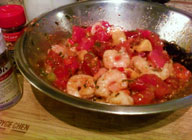 Ahi Poke is a local Hawaiian-American dish that originally involved preserving raw fish with sea salt and rubbing (lomi-lomi) it with seasonings and cutting it into small pieces. Seasonings made of seaweed, kukui nut, and sea salt were traditionally used for the Hawaiian poke. Since first contact with Western and Asian cultures, green onions, chili peppers and soy sauce have become common additions to it.
Ahi Poke is a local Hawaiian-American dish that originally involved preserving raw fish with sea salt and rubbing (lomi-lomi) it with seasonings and cutting it into small pieces. Seasonings made of seaweed, kukui nut, and sea salt were traditionally used for the Hawaiian poke. Since first contact with Western and Asian cultures, green onions, chili peppers and soy sauce have become common additions to it. Ahi Poke traditionally was meant to be different from sashimi, since the former is usually rough-cut pieces of fish piled onto a plate, and can be made with less expensive pieces of fish. In any event, today I have found some restaurant chefs using sashimi grade tuna anyway.
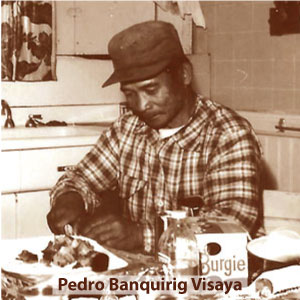
Ilokano Sailors
I really believe that Filipino sailors, some of which must have been Ilokano, introduced the technique of making Kilawin that influenced making Ahi poke and Lomi Lomi Salmon. I read somewhere in the book "Manila Men in the New World", by Floro L. Mercene, that suggests Filipino Sailors introduced the dish Kilawin to the natives in Mexico which directly influenced the dish Civiche', a popular seafood dish.
My suggestions is that the Filipino sailors were Ilokano and in the 150 years of trade between Manila and Acupulco other Filipino sailors spread the technique of making Kilawin around the Pacific to the Polynesians and influenced the making of Ahi Poke.
I really believe that Filipino sailors, some of which must have been Ilokano, introduced the technique of making Kilawin that influenced making Ahi poke and Lomi Lomi Salmon. I read somewhere in the book "Manila Men in the New World", by Floro L. Mercene, that suggests Filipino Sailors introduced the dish Kilawin to the natives in Mexico which directly influenced the dish Civiche', a popular seafood dish.
My suggestions is that the Filipino sailors were Ilokano and in the 150 years of trade between Manila and Acupulco other Filipino sailors spread the technique of making Kilawin around the Pacific to the Polynesians and influenced the making of Ahi Poke.
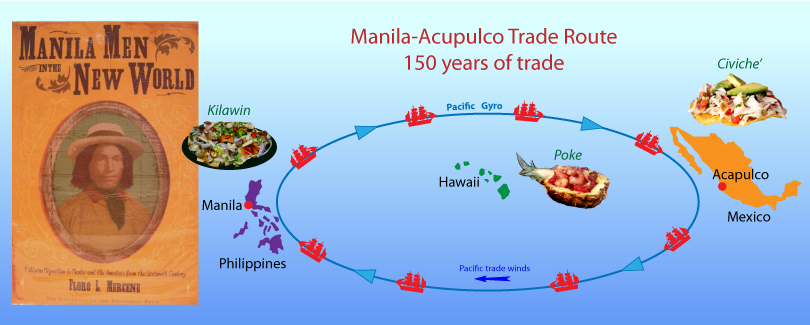
In Da Kine, Cloudy Eyes
I remember my father would go fishing a lot and would come home with his catch and would clean and fry them up for dinner. He loved to fish and would go everytime he had the chance. He went fresh water fishing alot but loved to go deep sea fishing when he could to catch tuna or salmon and would make lomi lomi salmon, or Kilawin na tuna also known in Hawaiian culture as Ahi Poke. He took me out deep sea fishing for the first time and I got so sea sick I kept throwing up in the bathroom of the boat. I remember it was me and this other Asian kid taking turns throwing up in the toilet. My dad thought it was pretty funny. When we got home I remember my dad laughing about it to my mom and making fun about me being American born.
He used to make different kinds of salads with fish and various types of seaweed. I guess whatever he could get his hands on at the time was fine. You just couldn't find fresh seaweed at your local Safeway grocery store.
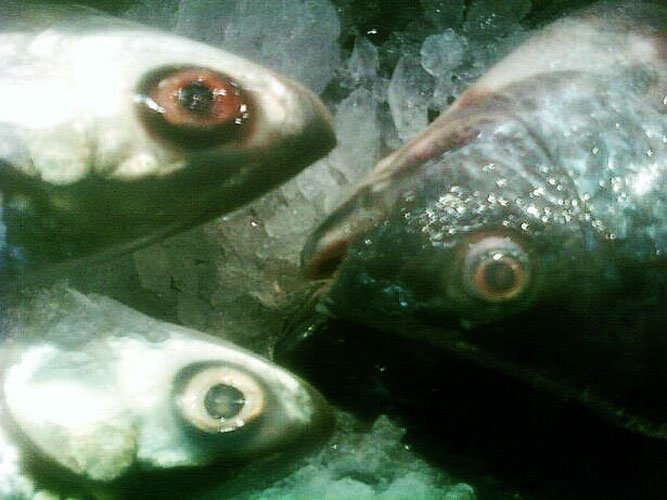 When my dad didn't go fishing and just wanted to get some fish he would go to Nishioka's Market on Sixth street in San Jose (California) they would sell fresh fish. When buying fish my dad would say to look at the eyes of the fish, if they're cloudy it's not fresh like the ones in the picture, if it's clear then it's fresh and those are the one's you want to buy. I always think about that fish eye lesson when I go to a market to buy fish.
When my dad didn't go fishing and just wanted to get some fish he would go to Nishioka's Market on Sixth street in San Jose (California) they would sell fresh fish. When buying fish my dad would say to look at the eyes of the fish, if they're cloudy it's not fresh like the ones in the picture, if it's clear then it's fresh and those are the one's you want to buy. I always think about that fish eye lesson when I go to a market to buy fish.
I also think about that lesson when dealing with people in general. Living without my Dad I had to learn the hard way about dishonesty and deceipt. I've learned to look people in the eye to determine how to judge their character whether honest or of a devious nature. The eyes tell it all. I believe in some cultures it's rude to look people straight in the eyes they may take that as a threat. I can pretty much determine a person's character through the look of their eyes. I believe you can find signs to tell if they're lying or being honest with you just by watching their eyes and body motions. I remember an old saying as well that says "you can see the parents through the eyes of their children". Which insinuates what values were taught to them by their parents and how they were raised as children. Stay away from cloudy eyes.
I remember my father would go fishing a lot and would come home with his catch and would clean and fry them up for dinner. He loved to fish and would go everytime he had the chance. He went fresh water fishing alot but loved to go deep sea fishing when he could to catch tuna or salmon and would make lomi lomi salmon, or Kilawin na tuna also known in Hawaiian culture as Ahi Poke. He took me out deep sea fishing for the first time and I got so sea sick I kept throwing up in the bathroom of the boat. I remember it was me and this other Asian kid taking turns throwing up in the toilet. My dad thought it was pretty funny. When we got home I remember my dad laughing about it to my mom and making fun about me being American born.
He used to make different kinds of salads with fish and various types of seaweed. I guess whatever he could get his hands on at the time was fine. You just couldn't find fresh seaweed at your local Safeway grocery store.
 When my dad didn't go fishing and just wanted to get some fish he would go to Nishioka's Market on Sixth street in San Jose (California) they would sell fresh fish. When buying fish my dad would say to look at the eyes of the fish, if they're cloudy it's not fresh like the ones in the picture, if it's clear then it's fresh and those are the one's you want to buy. I always think about that fish eye lesson when I go to a market to buy fish.
When my dad didn't go fishing and just wanted to get some fish he would go to Nishioka's Market on Sixth street in San Jose (California) they would sell fresh fish. When buying fish my dad would say to look at the eyes of the fish, if they're cloudy it's not fresh like the ones in the picture, if it's clear then it's fresh and those are the one's you want to buy. I always think about that fish eye lesson when I go to a market to buy fish. I also think about that lesson when dealing with people in general. Living without my Dad I had to learn the hard way about dishonesty and deceipt. I've learned to look people in the eye to determine how to judge their character whether honest or of a devious nature. The eyes tell it all. I believe in some cultures it's rude to look people straight in the eyes they may take that as a threat. I can pretty much determine a person's character through the look of their eyes. I believe you can find signs to tell if they're lying or being honest with you just by watching their eyes and body motions. I remember an old saying as well that says "you can see the parents through the eyes of their children". Which insinuates what values were taught to them by their parents and how they were raised as children. Stay away from cloudy eyes.
Nishioka's Fish Market
Last time I was down in Japantown San Jose there was a for sale sign on the old Nishioka's Fish Market building. That old brick building has been abandoned for some time now. I do believe it isn't seismically safe to occupy and would cost a lot to retrofit to current earthquake standanrds. I bet the next time I'm there it's probably going to be demolished and replaced with luxury condos. So to commemorate this childhood icon I made this CAD model of the old Nishioka's Market from memory. I added the Dungeness Crab and the shave ice signs as a personal touch.
Last time I was down in Japantown San Jose there was a for sale sign on the old Nishioka's Fish Market building. That old brick building has been abandoned for some time now. I do believe it isn't seismically safe to occupy and would cost a lot to retrofit to current earthquake standanrds. I bet the next time I'm there it's probably going to be demolished and replaced with luxury condos. So to commemorate this childhood icon I made this CAD model of the old Nishioka's Market from memory. I added the Dungeness Crab and the shave ice signs as a personal touch.
My Turn to make Ahi Poke!
Below are pictures of salads I believe are close to what my dad used to make except for some personal additions I made to taste. Below left isn't Ahi Poke but it's a salad he made when he has able to get a hold of that Pokpoklo seaweed. I just added tomatoes, shoyu sauce, and some olive oil. I should have added some sesame seeds as well.
In the middle-left I just added some shrimp and pineapple to an ahi poke recipe, It came out onolicious good!
On the right is simple quick Lomi Lomi Salmon. Just bought some Pico de Gallo salsa at a local Mexican market and mixed it together with pieces of chopped up salmon. Added some Shoyu sauce, sesame seeds, and some olive oil.
Below are pictures of salads I believe are close to what my dad used to make except for some personal additions I made to taste. Below left isn't Ahi Poke but it's a salad he made when he has able to get a hold of that Pokpoklo seaweed. I just added tomatoes, shoyu sauce, and some olive oil. I should have added some sesame seeds as well.
In the middle-left I just added some shrimp and pineapple to an ahi poke recipe, It came out onolicious good!
On the right is simple quick Lomi Lomi Salmon. Just bought some Pico de Gallo salsa at a local Mexican market and mixed it together with pieces of chopped up salmon. Added some Shoyu sauce, sesame seeds, and some olive oil.
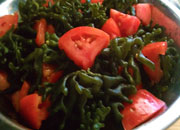 |
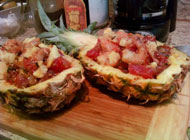 |
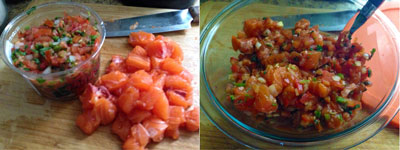 |
||
| Pokpoklo Seaweed Salad | Pineapple Shrimp Poke | Pico de Gallo Salsa mixed with chopped up peices of salmon |
Here are some restaurants in the SF Bay Area where Ahi Poke was on the menu. Some of them were pretty fancy but to be honest with you the best ones were the simple ones. The absolute best Ahi Poke I've ever tried was from Alicia's Market in Oahu Hawai and at Foodland Supermarkets. There they have different types of Hawaii style Ahi poke. Nobody makes Poke like Hawaii does.
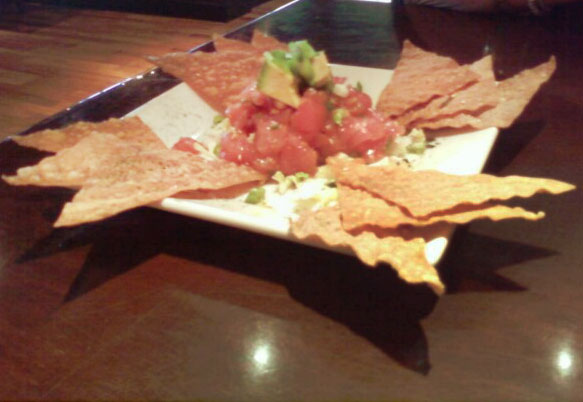 |
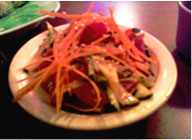 |
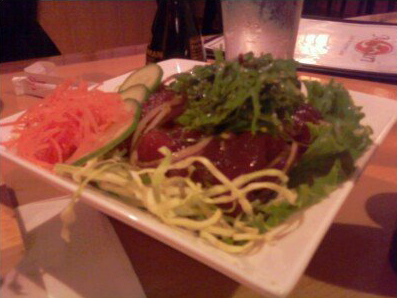 |
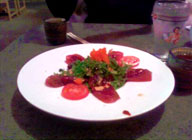 |
|||
| BJ's @ Tanforan Mall | Kai's - Alameda | Matsuri's - Vallejo | Miko's - Fairfield | |||
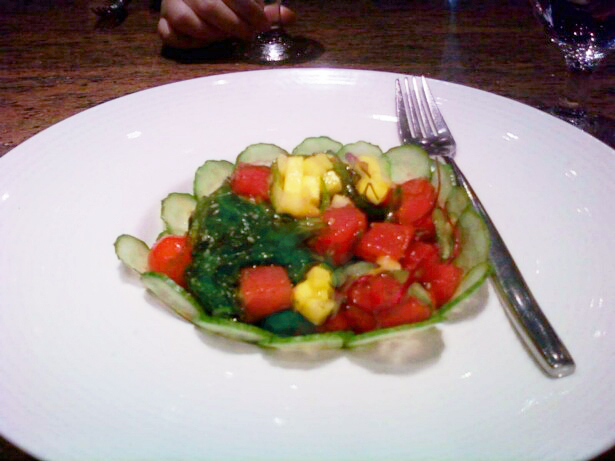 |
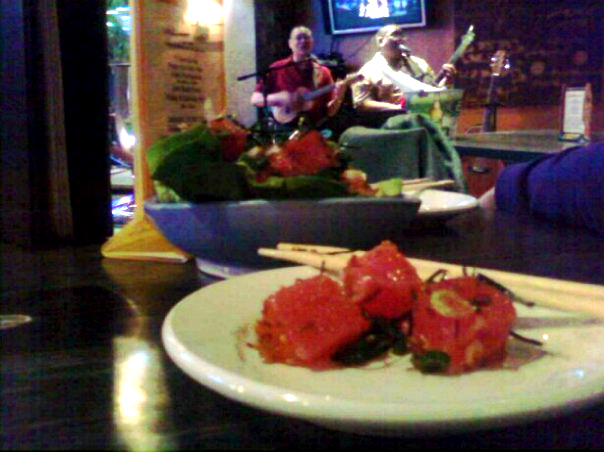 |
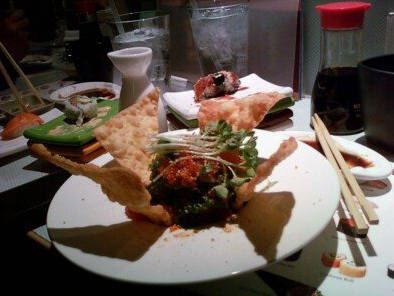 |
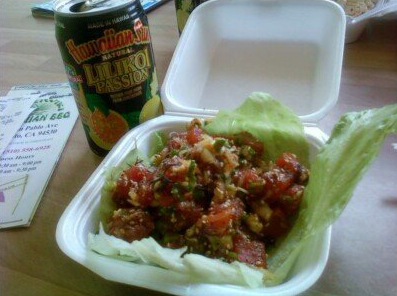 |
|||
| Osha Thai - SF | Sundance Kitchen - SF | Sushi Yu - American Canyon | Wikiwiki - El Cerrito |
SOME RECIPES
FROM: "Good Morning America" with Chef Emeril Lagasse
INGREDIENTS
PREPARATION: Combine all ingredients in a stainless steel bowl and gently mix.
FROM: "Good Morning America" with Chef Emeril Lagasse
INGREDIENTS
- 1 and 1/4 pound fresh ahi, cubed into bite-sized pieces
- 1/4 cup yellow onion, minced
- 1/4 cup green onion, sliced
- 3 tbsp. limu kohu, chopped (a soft, reddish-brown variety of seaweed, prized for its succulent flavor.)
- 1 tbsp. Inamona (the ground innards from roasted kukui nuts)
- 2 tsp. sesame oil
FROM: Recipe courtesy Tidepools, Koloa, HI, Sam Choy's Ahi Poke
INGREDIENTS
- 8 ounces tuna sashimi block, small dice
- 1/8 teaspoon Hawaiian salt
- 1/8 teaspoon kukui nut
- 1/2 teaspoon brown sugar
- Pinch chili flakes
- 1 teaspoon soy sauce
- 1 teaspoon oyster sauce
- 1 teaspoon green onion,chopped
- 1 tablespoon onion, chopped
- 1 teaspoon garlic, chopped
- 1 tablespoon Furukake spice
- 1 tablespoon sesame oil
PREPARATION: Combine all ingredients in a stainless steel bowl and gently mix.